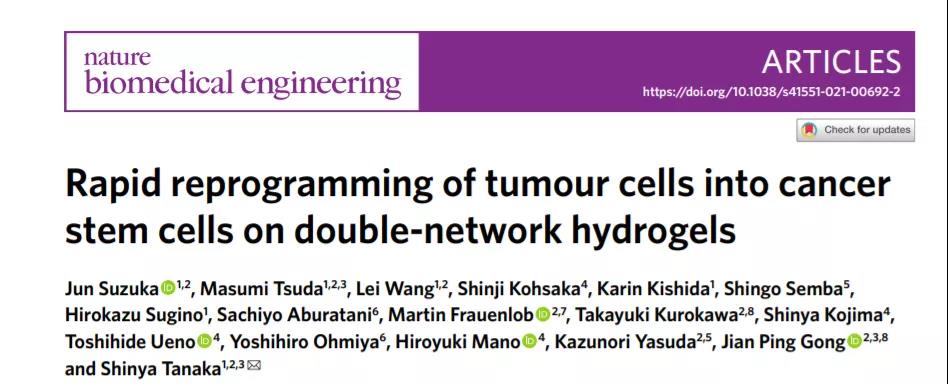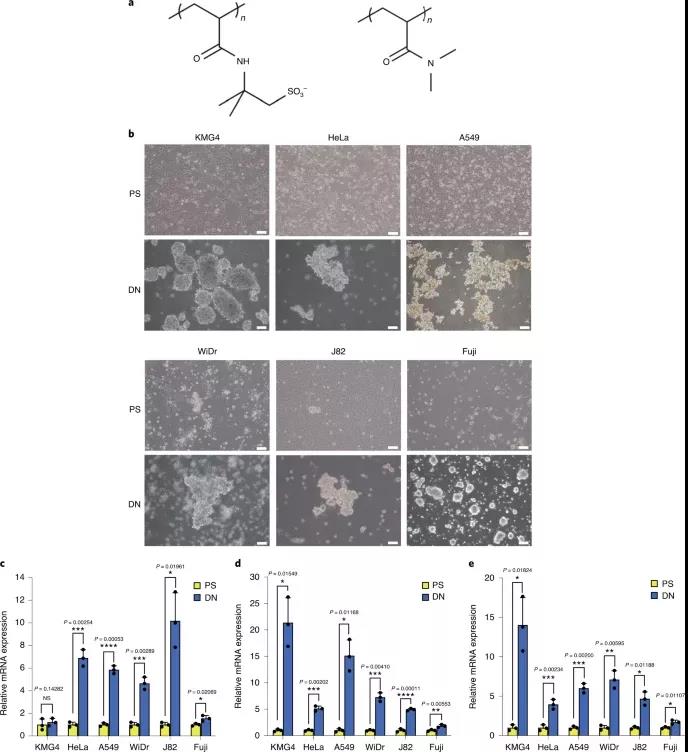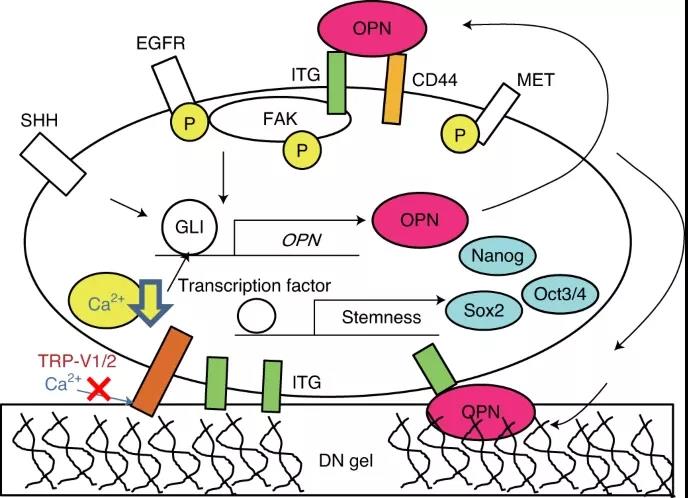Dual-network hydrogel is featured in Nature: Gong Jianping and Shinya Tanaka program cancer stem cells on the hydrogel
Cancer tissue consists of a heterogeneous population, which contains some cancer stem cells (CSC) and most differentiated non-CSCs. The growth rate of CSC is very slow and it is resistant to treatment. , CSCs can excrete chemotherapeutic agents outside the cell and enhance the protection of reactive oxygen species, which is particularly important for target therapy. However, it is very difficult to identify CSC cells because they are only present in a small amount in cancer tissues. At present, there is an urgent need to establish a rapid detection method for CSC.
The team of Shinya Tanaka and Gong Jianping of Hokkaido University in Japan used a dual network (DN) hydrogel to effectively detect CSC. The DN gel is composed of poly(2-acrylamido-2-methylpropanesulfonic acid) (PAMPS) and poly(N, N-dimethylacrylamide) (PDMAAm) composition, Youngs modulus is about 300 kPa. Polymer hydrogels are composed of a network structure containing a large amount of water, and their elastic modulus can simulate human tissues, so they exhibit soft and moist properties similar to biological tissues. This hydrogel can stimulate cell membranes and induce cell responses, leading to the expression of various genes. The results were published in the journal "Nature Biomedical Engineering" as "Rapid reprogramming of tumour cells into cancer stem cells on double-network hydrogels".

Key points and highlights:
1. The double network hydrogel can quickly reprogram differentiated cancer cells into CSC. DN gel plays a role in regulating the microenvironment of stem cells to induce cancer stem cells. After 6 human cancer cell lines were seeded on the DN gel, the cells began to aggregate, forming a spherical colloid representing CSC within 24 hours, and marker genes related to cancer stemness were observed.
2. Compared with brain cancer cells cultured on single network gel, human brain cancer cells cultured on DN hydrogel and injected intracranially into immunodeficient mice have higher tumorigenicity.
3. DN gel can interact with cell surface proteins including integrins to induce phosphorylation of tyrosine kinases. Gel-induced CSCs of primary brain cancer cells are inhibitors of platelet-derived growth factor receptors Elimination, thereby inducing the expression of proteins related to cell stemness (such as SHH 29 and GLI1).
4. This work uses DN gel to prove the molecular mechanism of cancer cell reprogramming, which will help identify agents that specifically eradicate CSC, thereby improving the treatment of cancer patients in the future. The author believes that the induction of CSCs by DN gel may promote three clinical applications: identification of new CSC markers, which can screen various cancer treatments, such as mesothelioma with increasing incidence; use of DN gel and Biopsy specimens from patients are used for early diagnosis of CSC, and then the patients can be treated by molecular targeted therapy; high-throughput reagent screening, especially reagents used to eliminate CSC.

Figure 1: DN gel rapidly induces CSC of 6 human cancer cell lines.

Figure 8: The molecular mechanism of the reprogramming phenomenon of hydrogel activation.
Original link:
https://www.nature.com/articles/s41551-021-00692-2
The team of Shinya Tanaka and Gong Jianping of Hokkaido University in Japan used a dual network (DN) hydrogel to effectively detect CSC. The DN gel is composed of poly(2-acrylamido-2-methylpropanesulfonic acid) (PAMPS) and poly(N, N-dimethylacrylamide) (PDMAAm) composition, Youngs modulus is about 300 kPa. Polymer hydrogels are composed of a network structure containing a large amount of water, and their elastic modulus can simulate human tissues, so they exhibit soft and moist properties similar to biological tissues. This hydrogel can stimulate cell membranes and induce cell responses, leading to the expression of various genes. The results were published in the journal "Nature Biomedical Engineering" as "Rapid reprogramming of tumour cells into cancer stem cells on double-network hydrogels".

Key points and highlights:
1. The double network hydrogel can quickly reprogram differentiated cancer cells into CSC. DN gel plays a role in regulating the microenvironment of stem cells to induce cancer stem cells. After 6 human cancer cell lines were seeded on the DN gel, the cells began to aggregate, forming a spherical colloid representing CSC within 24 hours, and marker genes related to cancer stemness were observed.
2. Compared with brain cancer cells cultured on single network gel, human brain cancer cells cultured on DN hydrogel and injected intracranially into immunodeficient mice have higher tumorigenicity.
3. DN gel can interact with cell surface proteins including integrins to induce phosphorylation of tyrosine kinases. Gel-induced CSCs of primary brain cancer cells are inhibitors of platelet-derived growth factor receptors Elimination, thereby inducing the expression of proteins related to cell stemness (such as SHH 29 and GLI1).
4. This work uses DN gel to prove the molecular mechanism of cancer cell reprogramming, which will help identify agents that specifically eradicate CSC, thereby improving the treatment of cancer patients in the future. The author believes that the induction of CSCs by DN gel may promote three clinical applications: identification of new CSC markers, which can screen various cancer treatments, such as mesothelioma with increasing incidence; use of DN gel and Biopsy specimens from patients are used for early diagnosis of CSC, and then the patients can be treated by molecular targeted therapy; high-throughput reagent screening, especially reagents used to eliminate CSC.

Figure 1: DN gel rapidly induces CSC of 6 human cancer cell lines.

Figure 8: The molecular mechanism of the reprogramming phenomenon of hydrogel activation.
Original link:
https://www.nature.com/articles/s41551-021-00692-2
18915694570
Previous: Advanced Science: 3D b


